 Case Report
Case Report
Adverse Effects of Chlorine Dioxide on Retina and Crystalline Lens
Arturo Solís Herrera*
Human Photosynthesis Research Center, CS Aguascalientes, México
Arturo Solís Herrera, Human Photosynthesis Research Center, CS Aguascalientes, México, USA.
Received Date: Aug 13, 2021; Published Date: September 19, 2021
Abstract
We evaluate two patients that use chlorine dioxide on its own initiative, influenced by news, friends, etc., but not prescribed by doctors. The patients did not know the concentration they used even though they ingested it for more than 12 months. The concentrations used in the laboratory and in clinical trials are low, 5 ppm, and 0.1 ppm. Hemolysis and renal dysfunction have been reported at concentrations of 40 ppm. The patients came to control their eye problems, but the findings differed significantly from those found before the intake of chlorine dioxide.
Keywords: Chlorine Dioxide; Retina; Hemorrhage; Lens; Cataract
Background
Chlorine dioxide (ClO2) is a chemical compound consisting of one chlorine atom and two oxygen atoms. It is a reddish to yellowish-green gas at room temperature that dissolves in water. It is used for a variety of antimicrobial uses, including the disinfection of drinking water. When added to drinking water, it helps destroy bacteria, viruses and some types of parasites that can make people sick, such as Cryptosporidium parvum and Giardia lamblia. The Environmental Protection Agency (EPA) regulates the maximum concentration of chlorine dioxide in drinking water to be no greater than 0.8 parts per million (ppm). Chlorine dioxide chemistry is used in a wide variety of industrial, oil and gas, food, and municipal applications, for instance: Chlorine dioxide can be used as an antimicrobial agent in water used in poultry processing and to wash fruits and vegetables. Chlorine dioxide is used to chemically process wood pulp for paper manufacturing. In hospitals and other healthcare environments, chlorine dioxide gas helps to sterilize medical and laboratory equipment, surfaces, rooms, and tools. Researchers have found that at appropriate concentrations, chlorine dioxide is both safe and effective at helping to eliminate Legionella bacteria in hospital environments. Legionella pneumophila bacteria can cause Legionnaires’ disease, a potentially deadly type of pneumonia. Chlorine dioxide is not a cure or treatment for medical ailments, including but not limited to autism, HIV, malaria, hepatitis viruses, influenza, common colds, and cancer. Claims that the ingestion of chlorine dioxide, often advertised as “Miracle Mineral Solution” or MMS, will cure these or other ailments are false [1]. Chloride Ion is a chlorine anion that forms the negatively charged part of certain salts, including sodium and hydrogen chloride salts, and is an essential electrolyte located in all body fluids responsible for maintaining acid/base balance, transmitting nerve impulses and regulating fluid in and out of cells. Chloride is a halide anion formed when chlorine (Cl2) picks up an electron to form an anion. It has a role as a human metabolite, an Escherichia coli metabolite, and a cofactor. It is a halide anion and a monoatomic chlorine. It is a conjugate base of a hydrogen chloride (HCl) [2]. It is used as Pesticide, fertilizer, and other agricultural chemical manufacturing.
Introduction
Chlorine dioxide can be rapidly absorbed through the gastrointestinal tract. Peak blood concentration levels can be reached within 1 h after a single dose administered orally. It can also be slowly absorbed through shaved skin with a half absorption time of 22 h. It seems unlikely that intact chlorine dioxide is absorbed by inhalation giving its highly reactive nature; it is more likely that its derivatives can be absorbed [3]. Chlorine dioxide is metabolized to chlorite (ClO2), chlorate (ClO3), and mostly chloride (Cl). Most administered chlorine dioxide and its metabolites remain in plasma followed by kidneys, lungs, stomach, intestine, liver, and spleen. About 43% of orally administered chlorine dioxide is eliminated in the urine and feces within 72 h. It is not excreted via the lungs.
Case 1
This is a female patient, dated August 6, 1942, diagnosed with chronic open-angle glaucoma. She was using hypotensive treatment that caused him marked discomfort, so after 2 years he went with us. She was treated in our office, for the first time, on May 19, 2019. Her SpO2 was 94%, her heart rate was 73 beats per minute, and sciascopy revealed mild farsightedness. The examination showed findings compatible with glaucomatous optic neuropathy (NOG) or lowtension glaucoma. The photographs taken at the time of the first examination are as follows: (Figure 1-4)
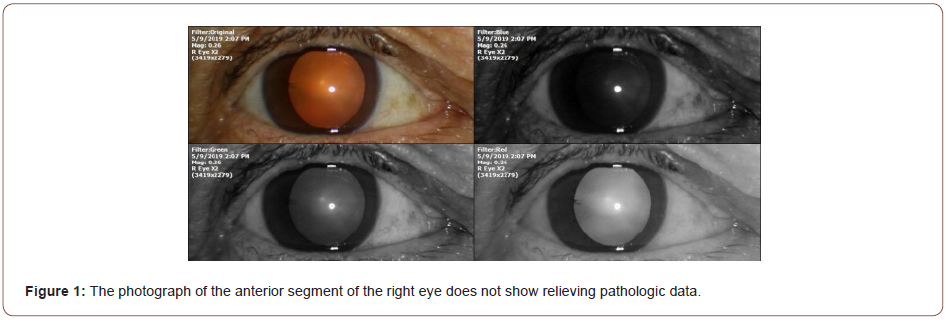



She did not attend a consultation for the whole of 2020, and part of 2021 due to covid restrictions, but continued to use the treatment. The patient started using chlorine dioxide from the beginning of the year 2020 and to date, on the advice of friends and family and was not prescribed by a doctor. The patient went to the consultation for the second time, on July 5, 2021, due to the appearance of a dark spot in the visual field in left eye a few weeks ago. The photographs taken at the time of the second consultation are as follows: (Figure 5-8)
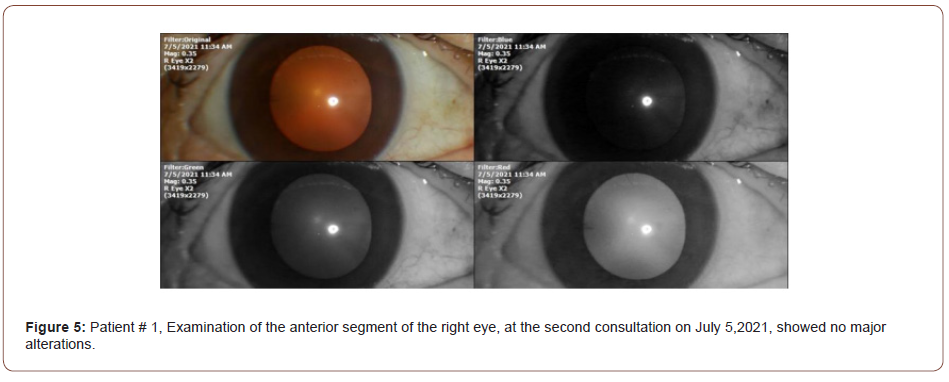

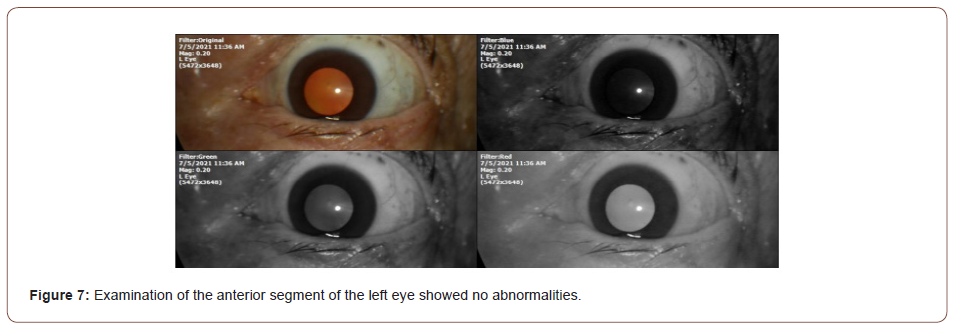
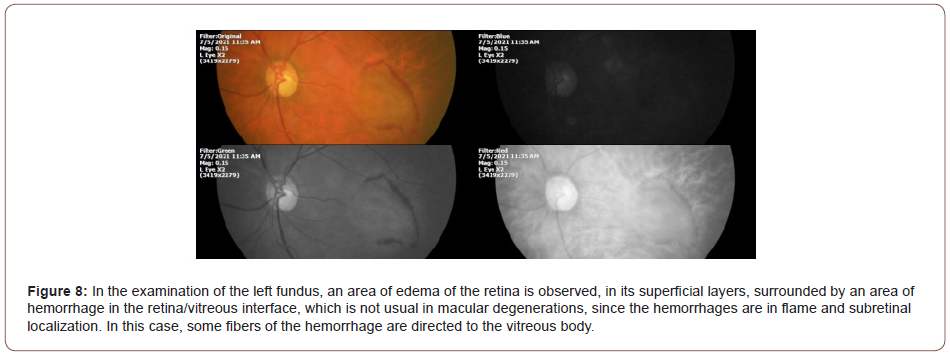
The unusual features of retinal lesion in the right eye, affecting shallow rather than deep layers, and the arrangement of hemorrhage; suggest that they may have been caused by the chemical agent dioxide chlorine, used in doses higher than advisable.
Case 2:
Female patient, born on February 25, 1943, and comes to consultation for the first time in 2014 for distortion of vision in the central region of the visual field. She was diagnosed with rightpredominating bilateral idiopathic pre-macular gliosis. The patient evolved positively with gliosis of the left eye, which disappeared completely, gliosis of the right eye showed slight improvement. Over time, he developed a cataract in his right eye, which was operated on surgically, placing an intraocular lens (Figure 9, 10). In the left eye, in which gliosis disappeared with our treatment; there were small opacities that did not interfere with vision, so the management was conservative (Figures 9-13).

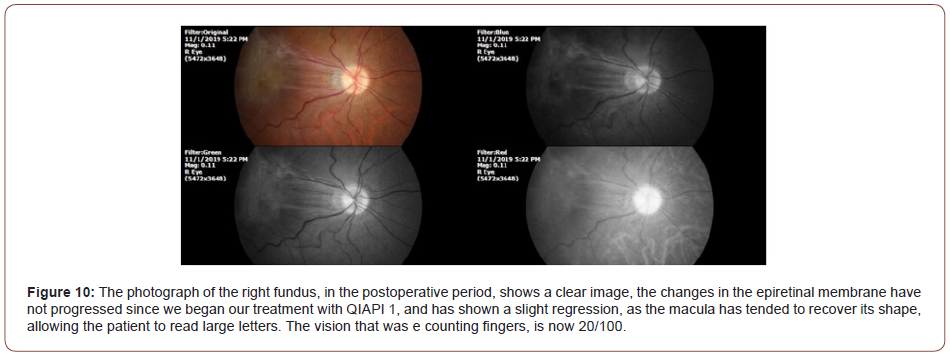

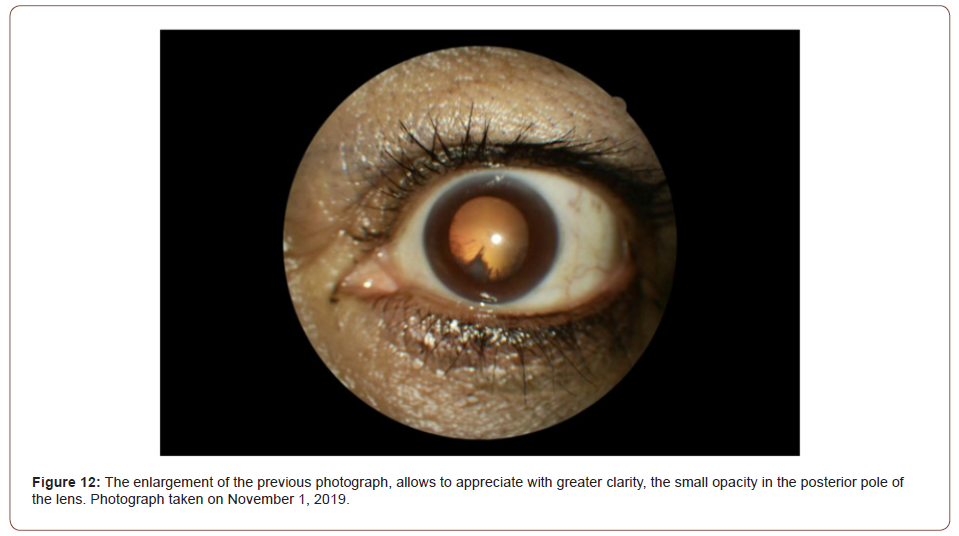
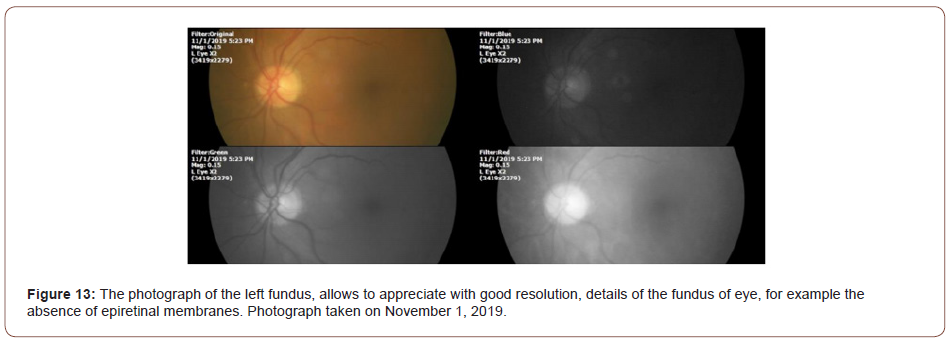
He patient did not attend her check-ups every six months due to travel restrictions due to COVID19. So, the last time she came was on November 1, 2019. Although she could not come for review, she continued to use his treatment. The patient went to consultation on July 21, 2021, because 4 weeks ago she noticed that the vision of her left eye began to decline (Figure 14-17).
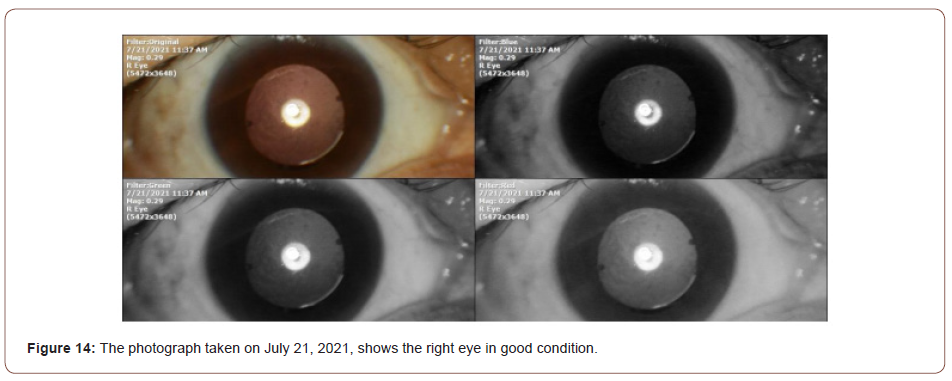


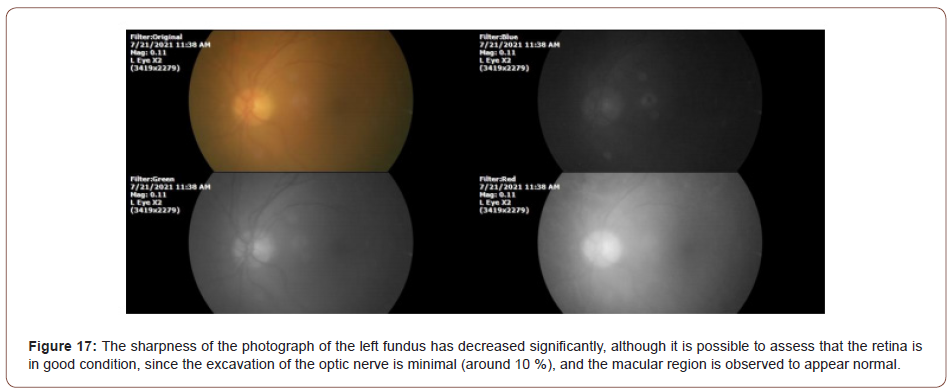
The increase in the opacity on central part of posterior capsule in the left eye, coincides with the ingestion of chlorine dioxide without a prescription and at unknown doses, during a period of approximately 10 to 12 months.
Discussion
The oxidative injury from sodium chlorite (NaClO2) initiated a complex response, with inflammatory and autoimmune components. It is difficult to discern the effects of this compound when it is introduced into the human body, given its complex metabolism. It has been described in the literature histiocytic necrotizing lymphadenitis or Kikuchi-Fujimoto disease after ingestion of sodium chlorite (MMS) [4]. There have been only a handful of case reports of KFD occurring after a physical trigger, such as breast implants [5], pacemaker insertion [6], or gastric bypass surgery [7]. It is touted by its distributors and creator to cure malaria, AIDS, viral hepatitis and even cancer, without harming human cells. Its purported mechanism of action is via oxidation, in a manner like how chlorine dioxide is used for water disinfectant ex vivo. There is, however, no evidence published in any peer-reviewed journal to support the claims in an in vivo model. On the contrary, several government agencies in the USA [8] Canada [9], and the UK [10], warn of side effects of nausea, severe vomiting, diarrhea, dehydration, and hypotension. Its sale is banned in those countries. Laboratory tests show a nonspecific inflammatory response, as it happens in viral, bacterial, and parasitic infections. Unspecific inflammatory responses are also observed in autoimmune and neoplastic diseases. There are only two reported cases of human intoxication with sodium chlorite. One patient ingested an unmeasured amount of 28% sodium chlorite solution diluted with water [11]. The other patient ingested 10 drops diluted in 100 mL of water [12]. That is approximately equivalent to 36 mL of 28% solution. The toxic effects of chlorite ions are due to oxidative damage. Early symptoms of toxicity include nausea, vomiting, abdominal pain, diarrhea, and dehydration likely due to irritation of the gastrointestinal mucosa. Later systemic toxic effects are due to oxidation of hemoglobin to methemoglobin, resulting in respiratory distress, hemolysis, and renal failure [13]. Sodium chlorite (NaClO2) is a powerful oxidizing agent with multiple commercial applications. Therefore, the odds of accidental ingestion are significant. Moderate methemoglobinemia, severe oxidative hemolysis, disseminated intravascular coagulation, acute renal trauma with anuria have been described. A 9-year-old boy presented with his brother after they accidentally ingested a small amount of undiluted 22.4% sodium chlorite. Symptoms include nausea, vomiting, diarrhea, and dyspnea. Oxygen saturation remained 71% despite supplemental oxygen (15L/min). The patient was noted to have dark chocolate-appearing blood, minimal urine output, diffuse pallor, and cyanosis. He developed methemoglobinemia, renal failure requiring renal replacement therapy and hemolysis requiring blood transfusion [14]. The case of a 55-year-old man who attempted suicide by ingesting <100 mL of 28% sodium chlorite solution was published. On arrival in the intensive care unit, the patient appeared cyanotic with lowered consciousness and displayed anuria and chocolate brown serum. Initial laboratory tests revealed 40% of methemoglobin. The formation of methemoglobin was effectively treated with methylene blue (10% after 29 hours). To remove the toxin, and because of the anuric acute renal failure, the patient received renal replacement therapy. Despite these therapeutic measures, the patient developed hemolytic anemia and disseminated intravascular coagulation, which were treated with red blood cell transfusion and intermittent hemodialysis. These interventions led to the improvement of his condition and the patient eventually fully recovered [15]. In another reported case, a 55‐year‐old male who developed acute kidney injury and disseminated intravascular coagulation after chlorine dioxide prophylactic ingestion, with regression after therapy with hemodialysis [16]. In experimental studies, it was shown that acute and chronic toxicity were associated with insignificant hematological changes. Acute kidney injury due to chlorine dioxide has been reported several times. Two cases of renal toxicity due to its metabolites, chlorate and chlorite were reported by Bathina et al [17]. Also, a case of myocardial damage induce by chlorine dioxide poisoning has been reported [18]. Chlorine dioxide-induced acute hemolysis [19] is a constant finding. In the Chinese literature reports of chlorine dioxide poisoning are frequent [20].
Conclusion
For 3 or 4 centuries, it has been observed that many poisons, in low doses, can induce favorable responses from the body, although fleeting, such as homeopathy. At higher doses, the positive effects fade and intoxications appear, like homeopathy. The problem is that it is not understood, at a biochemical level, because poisons kill, and in the same way they are not understood because poisons can briefly improve health. Therefore, it is very difficult to determine the right dose for each person because it is not known at what time we are improving it or at what time we are poisoning it. Using substances like this indiscriminately has significant risks. Physicians should be aware of a patient’s use of alternative treatments when considering differentials in a diagnostic dilemma. Potential risks and benefits of alternative treatments should be discussed with patients, and patients advised accordingly.
Acknowledgement
This work was supported by an unrestricted grant from Human Photosynthesis® Research Centre. Aguascalientes 20000, México.
Conflict of Interest
None.
References
- (2021) Chlorine Dioxide National Library of Medicine. PubChem: Chlorine Dioxide Use, Benefits, and Chemical Safety Facts.
- (2021) Chloride Ion. PubChem: Chloride ion Cl.
- Gómez-López VM (2014) Chlorine Dioxide, in Encyclopedia of Toxicology. (3rd), Editor-in Chief Philip Wexler.
- Loh JM, Shafi H (2014) Kikuchi-Fujimoto disease presenting after consumption of 'Miracle Mineral Solution' (sodium chlorite). BMJ Case Rep 2014: bcr2014205832.
- Sever CE, Leith CP, Appenzeller J, Foucar K (1996) Kikuchi's histiocytic necrotizing lymphadenitis associated with ruptured silicone breast implant. Arch Pathol Lab Med 120(4): 380-385.
- Charalabopoulos K, Charalabopoulos A, Binolis J, Papalimneou V, Ioachim E (2002) Is implant pacemaker a physicochemical cause triggering Kikuchi-Fujimoto disease. In Vivo 16(1): 73-76.
- Garcia-Arnes J, Bernal-Lopez MR, Gallego-Perales JL, Vazquez-Camuñas ML, Gomez-Huelgas R (2012) Histiocytic necrotizing lymphadenitis (Kikuchi-Fujimoto disease) after laparoscopic Roux-en-Y gastric bypass for morbid obesity: a case report. J Med Case Rep 6: 340.
- (2010) FDA Warns Consumers of Serious Harm from Drinking Miracle Mineral Solution (MMS). FDA News Release.
- Carruthers Czyewski P (2012) Candian Adverse Reaction Newsletter. 22(2): 4.
- (2012) Agency warning on chlorine solutions. Food Standards Agency News and Updates.
- Romanovsky A, Djogovic D, Chin D (2013) A case of sodium chlorite toxicity managed with concurrent renal replacement therapy and red cell exchange. J Med Toxicol 9(1): 67-70.
- Lin JL, Lim PS (1993) Acute sodium chlorite poisoning associated with renal failure. Ren Fail 15(5): 645-648.
- Bhattacharyya A, Chattopadhyay R, Mitra S, Crowe SE (2014) Oxidative stress: an essential factor in the pathogenesis of gastrointestinal mucosal diseases. Physiol Rev 94(2): 329-354.
- Zhen J, Hakmeh W (2021) Siblings with pediatric sodium chlorite toxicity causing methemoglobinemia, renal failure and hemolytic anemia. Am J Emerg Med 42: 262e3-262e4.
- Gebhardtova A, Vavrinec P, Vavrincova-Yaghi D, Seelen M, Dobisova A, et al. (2014) A case of severe chlorite poisoning successfully treated with early administration of methylene blue, renal replacement therapy, and red blood cell transfusion: case report. Medicine (Baltimore) 93(9): e60.
- Medina-Avitia E, Tella-Vega P, García-Estrada C (2021) Acute kidney injury secondary to chlorine dioxide use for COVID-19 prevention. Hemodial Int.
- Bathina G, Yadla M, Burri S, Enganti R, Prasad Ch R, et al. (2013) An unusual case of reversible acute kidney injury due to chlorine dioxide poisoning. Ren Fail 35(8): 1176-1178.
- Zhao M, Wang Y (2005) One case of myocardial damage induced by chlorine dioxide poisoning. Zhonghua Lao Dong Wei Sheng Zhi Ye Bing Za Zhi 23(6): 470.
- Kishan H (2009) Chlorine dioxide-induced acute hemolysis. J Med Toxicol 5(3): 177.
- Liu RJ, Ren AN (2016) Six patients with chlorine dioxide poisoning. Zhonghua Lao Dong Wei Sheng Zhi Ye Bing Za Zhi 34(12): 937-938.
-
Arturo Solís Herrera. Adverse Effects of Chlorine Dioxide on Retina and Crystalline Lens. W J Opthalmol & Vision Res.3(5): 2021. WJOVR.MS.ID.000571. DOI: 10.33552/WJOVR.2021.03.000571.
-
Chlorine Dioxide, Retina, Hemorrhage, Lens, Cataract, Environmental Protection Agency, Legionella Pneumophila Bacteria, Miracle Mineral Solution, Dehydration, Hypotension
-

This work is licensed under a Creative Commons Attribution-NonCommercial 4.0 International License.






